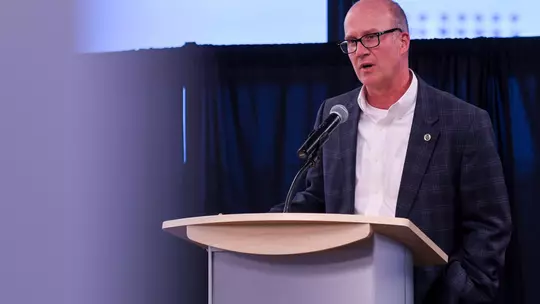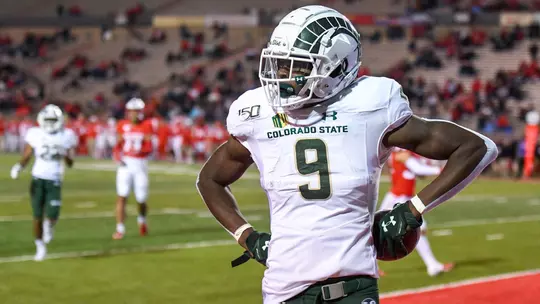
CSU Adjusting to "Fluid and Uncertain Environment"
Student-Athletes request more transparency with pandemic plans
Mike Brohard
Through it all, Joe Parker has held on to two words when it comes to dealing with the coronavirus pandemic.
They were the same back in March when the spring season was shut down, and they never left his consciousness as student-athletes were welcomed back to campus with intake testing. The outbreak on the football team, and the voluntary decision of the athletic department to put the program’s work on hold until Aug. 13 hasn’t altered his outlook.
“We’ve built some real sound protocols in place to try and manage as best as we can in this very fluid and uncertain environment,” Colorado State’s Director of Athletics said.
For the most part, the student-athletes who have returned have felt the athletic department was doing what it could to put their health at the forefront of their decisions, though at first, some weren’t sure if that was the case. Senior wide receiver Warren Jackson was one of them, but the actions of the voluntary pause on football and the retesting conducted Monday, he feels more confident now.
“I felt it’s inevitable (to have an outbreak). Just the way we’re living, we’re college student-athletes,” Jackson said. “We don’t have all the resources, especially at this time. We can’t truly quarantine. We have to go to the store, or get something for the car. I would say it’s inevitable. At first, I wasn’t sure they had our best interests in mind, but my opinion has changed. They jumped on it pretty quick. They’ve taken the right precautions, that if a whole house is sick, one guy can’t show up. I think they’ve taken a lot of precautions to provide that safety for us.”
When 10 football players tested positive recently, the first decision was for the athletic department’s voluntary pause in team workouts. Other sports on campus – which include men’s and women’s basketball, volleyball, women’s soccer and now men’s and women’s cross country – are free to continue under the guidelines put in place by the CSU Pandemic Preparedness Team. The positive results also led to 150 COVID-19 tests on Monday (which stood as the mandatory intake testing for cross country).
To this point, the university and health partner UCHealth has tested 420 athletes and is still awaiting Monday’s results, which Parker said could take up to 72 hours. They were getting results within 24 hours, but Parker said the surge in testing in Larimer County has led to the additional wait time.
Parker said any athletes who feel uncomfortable with playing due to COVID-19 can opt out and still retain their scholarship, no questions asked. However, he noted that will remove them from all team activities, with the exception of academic services. The reason being if athletic teams are trying to maintain a bubble, it has to include only those who are active performers.

There have been 16 positive tests as a result, 11 of them on the football team. Six of those players are still considered active cases. For Parker, none of them are viewed as a negative result, but part of the process.
“Positive tests, in my opinion, are affirmations we’re being successful with our protocols. I don’t view them as failures,” he said. “We’re interested in detecting viral spread. We want to identify it, isolate it and protect as many people as possible. We did have creeping up in our positives, and that’s what necessitated the pause in football last Wednesday.”
Each positive result has led to contact tracing, conducted by CSU’s Public Health Department. Parker noted those results may lead to self-isolation or quarantine situations for individuals who have been within 6 feet of a positive-result patient for at least 15 minutes without a mask. Lori Lynn, the executive director of CSU’s Health Network, said the campus has plans in place for all students – on or off campus – to transition them from a residence hall to a designated quarantine area, with meal delivery to their door and services for counseling and academics.
Lynn said the current recommendations for a known positive is for a 10-day quarantine starting from the onset of symptoms. For a person who has been in close contact with a known positive, it is 14 days.
Colorado State has had 54 student-athletes who completed a 10- or 14-day quarantine, with four doing both. There were 26 who did 10-days, 24 who completed 14. The time frame for those in quarantine ranged from June through the end of July.
For the student-athletes involved, they still have concerns, no matter what protocols are in place by the athletic department.
“The biggest concern is getting started. We’re starting right now, but then getting our season wiped from us, and it feels inevitable at this point,” senior soccer captain Bailyn Furrow said. “I know everyone says to train like you’re going to play, but watching all the other conferences cancel and schools cancel, it’s really hard mentally right now to get in the drive for season. We’re all worried we’re going to put in a ton of work and get our season stripped away.”
Some of her teammates, she said, are worried about travel, especially when it comes to hot spots in Northern California or Texas, both places the Rams’ soccer team is currently set to visit. As the director of operations for the Student-Athlete Advisory Committee, Furrow said other concerns have come to light, some of which she noted have been addressed.
For instance, she said some student-athletes felt they were being left in the dark about who has tested positive, but it was then explained to them – and reiterated by Parker in a conference call with the media on Monday – HIPAA regulations do not allow to make public those results.
Still, additional transparency is a request. For instance, the soccer team regularly holds captain’s practices before the official start of training, but those were nixed without advanced warning.
“I would like to see them be more straight forward and sometimes explaining why certain rules are in place,” Furrow said. “I feel sometimes we’re just told this is what we’re doing and there’s not really an explanation. I think it’s helpful if they give you a purpose in why it’s happening and why it’s the procedure and why we’re doing this way. I think it will be easier for athletes to comprehend why I may be out this long. Just more transparency of why rules are being decided.”
When the additional testing was announced for Monday, it provided another layer of reassurance for Jackson, Furrow and senior quarterback Patrick O’Brien, who said he and others are concerned about teammates who may be symptomatic but still exposing teammates to the virus. Parker said it was planned in advance for football before heading into more intense workouts, but if the players had been told prior, they would have felt better about being kept informed.
For someone who wants the season to take place, keeping the players healthy is his ultimate concern, and with the recent outbreak, O’Brien believes the players have a better understanding of the role they ultimately play.
“We did a great job, then we kinda fell apart before we got shut down. If we can get back to where everyone is healthy and we can play and practice, then we should do it,” he said. “That’s how I feel. I think they’re doing all they can really do. You can’t really control all aspects of everyone’s lives. What they can control, I thought they were doing a good job at it.”

I would like to see them be more straight forward and sometimes explaining why certain rules are in place. I feel sometimes we’re just told this is what we’re doing and there’s not really an explanation. I think it’s helpful if they give you a purpose in why it’s happening and why it’s the procedure and why we’re doing this way. I think it will be easier for athletes to comprehend why I may be out this long. Just more transparency of why rules are being decided.Bailyn Furrow, Women's Soccer Player and SAAC Director of Operations
Jackson said the coaching staff has been supportive and vigilant. When he had a sore throat, he was told to first stay away from the team, then to take all the time he needed to get fully healthy before his return.
Part of the protocol in place is health checks, not just temperatures taken but the reporting of any kind of symptoms by student-athletes to their trainers. Furrow said the idea of missing training time has weighed heavily on some of her teammates.
“If somebody feels like if they’re the slightest bit sick, everyone is afraid to say anything,” she said. “They don’t want to get taken out of practice, which needs to change, and it comes down to a personal level. I’ve heard that from my teammates, like I have a slightly sore throat, but I don’t want tell (athletic trainer) Sarah Weatherford because I’ll get taken out of training and I don’t want to fall behind. I want to fight for my position to start, but if I’m gone for two weeks … I think there’s a hard balance of when to talk and when to not. Before COVID-19, you would tell your trainer everything, and I feel athletes are afraid to tell their trainer anything.”
In the next month, there will be up to 30,000 people on the CSU campus when classes start, and the idea of keeping student-athletes in a bubble is quickly erased. At this point, all football activities have been held outside, with no access to the locker room and team meals distributed in boxes.
Taking into account the team’s outbreak, and the travel across campus to classes and various venues, the idea of taking care of themselves will take on an even added layer of importance, tight end Trey McBride said.
“Absolutely. Coach Steve Addazio has done a tremendous job of making sure we’re doing just that,” McBride said. “Even at practice, he’s making sure we’re only as close as we ned to be when we need to be. He’s really done a great job of stressing social distancing and wearing masks. He’s told us we don’t need to go out and do all those other things, there will be time for that. Ultimately, it’s our goal to play this year, and if we don’t do those things, then it’s not going to happen.”
The athletic department hoped to avoid any outbreaks, but there was a plan in place for the moment it occurred. Parker remains encouraged a fall season can take place, but he’s realistic there are challenges ahead.
“Is all of this going to be the absolute answer that gets us to the point where we can navigate through the academic year and the fall sports schedule and the winter and springs sports schedule … Those are all still things that are yet to be determined,” Parker said. “The two operative words always seem to be uncertainty and fluid, and that’s where I feel we’re in right now too.”
